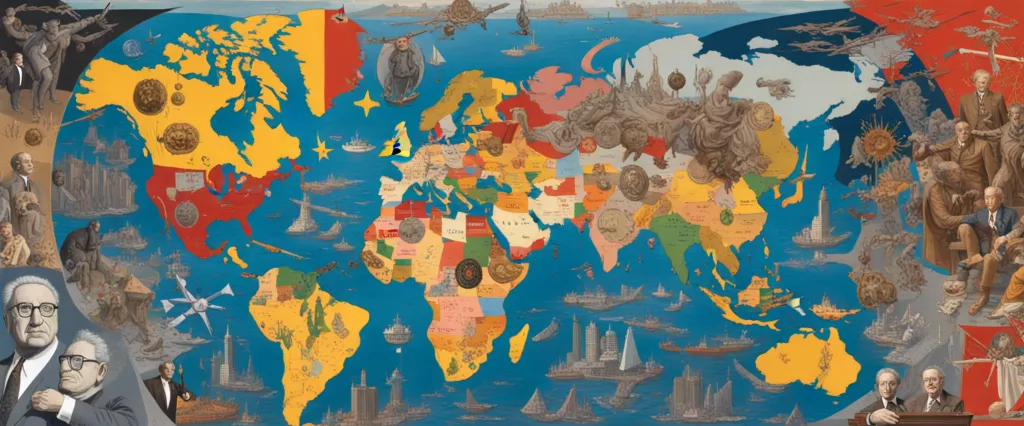In his groundbreaking work, “World Order,” Henry Kissinger provides a captivating analysis of the global power dynamics that have shaped our modern world. Drawing upon his immense political expertise and firsthand experience as a diplomat, Kissinger unveils the intricate balance of power, values, and interests that have characterized international relations throughout history. As the former Secretary of State and National Security Advisor under two U.S. presidents, Kissinger’s insights into world affairs are unparalleled, making “World Order” an indispensable resource for understanding the complex tapestry of global politics.
Chapter 1: Introduction: The Quest for World Order
In Chapter 1 of “World Order” written by Henry Kissinger, the author discusses the intricate structures and challenges faced by nations in their pursuit of establishing a global world order. Kissinger asserts that throughout history, different regions have had distinct concepts of order, underpinned by religious, philosophical, and cultural values. However, with nations becoming more interconnected, the search for a universal world order has become critical.
Kissinger emphasizes the need for a global order to maintain stability and prevent conflicts. He highlights that the balance of power has been a predominant concept since the Peace of Westphalia in 1648, framing relations among nation-states. This approach aimed to prevent any single country from dominating others and fostered a system of diplomacy and negotiations.
The author further explores the inherent challenges in establishing a world order. He discusses the tension between national interests and the aspiration for global stability. Kissinger delves into the dilemma faced by various nations, such as the United States and China, which must balance their domestic needs with their international responsibilities. He explores the conflicting ideologies, different political systems, and economic disparities that hinder efforts to create a harmonious global order.
Throughout the chapter, Kissinger emphasizes the significance of understanding historical and cultural contexts in shaping world order. He argues that the Westphalian system, despite its limitations, provides a stable framework to avoid chaos on a global scale.
In summary, Chapter 1 sets the stage for the subsequent exploration of different regions’ approaches to world order. Kissinger underscores the fundamental challenges and complexities intertwined with establishing a global order, urging policymakers and diplomats to consider historical precedent and cultural diversity to shape a more stable future.
Chapter 2: Westphalian Order and Its Challenges
Chapter 2 of Henry Kissinger’s book “World Order” explores the Westphalian Order and the challenges it faces. The Westphalian Order refers to the 1648 Peace of Westphalia, which ended the Thirty Years’ War and laid the foundation for the modern state system.
Kissinger argues that the Westphalian Order is based on two fundamental principles: the principle of sovereignty and the principle of non-interference. Sovereignty means that each state has exclusive control over its own territory, government, and domestic affairs. Non-interference means that states are expected to respect each other’s sovereignty and not interfere in the internal affairs of other states.
However, Kissinger acknowledges that the Westphalian Order faces significant challenges in the 21st century. The rise of non-state actors, such as international organizations, terrorist groups, and transnational corporations, undermines the traditional notion of sovereignty. These actors operate across national borders and challenge the authority of individual states.
Furthermore, globalization has interconnected states and their economies, making it impossible for any state to isolate itself completely. This interdependence often leads to conflicts of interest and challenges the Westphalian principle of non-interference.
Additionally, the spread of information technology has increased the flow of information and empowered individuals, making it difficult for states to control and regulate international affairs. This democratization of information and communication threatens the traditional dominance of nation-states over global affairs.
In conclusion, Chapter 2 highlights the challenges facing the Westphalian Order, particularly in an increasingly interconnected and globalized world. Kissinger suggests that the future world order must adapt to address these challenges while still preserving the principles of sovereignty and non-interference.
Chapter 3: The Balance of Power in Europe
Chapter 3 of Henry Kissinger’s book “World Order” explores the concept of the balance of power in Europe. The author delves into the historical events and philosophical ideas that shaped the balance of power system, highlighting its significance in maintaining stability and preventing the domination of any single European nation.
Kissinger begins by discussing the Peace of Westphalia, which concluded the Thirty Years’ War and established the principles of state sovereignty and non-intervention. This treaty inaugurated the balance of power system in Europe, where nations sought to maintain equilibrium by forming alliances and ensuring no state became too powerful. This mechanism aimed to deter aggression and preserve the autonomy and independence of states.
The author then examines the Congress of Vienna, a 19th-century gathering that aimed to restore the European balance of power following the Napoleonic Wars. This conference notably established the concept of legitimacy, where the legitimacy of a state’s ruler depended on the support of other European powers.
Kissinger also explores how the two world wars greatly disrupted the balance of power in Europe. The rise of Germany as a dominant power triggered conflicts, and the aftermath of each world war compelled the victors to reorganize the international order and establish institutions such as the League of Nations and later, the United Nations. However, these attempts fell short due to power imbalances and the failure to address the underlying causes of conflict.
In conclusion, Kissinger argues that the balance of power system in Europe served as a foundation for stability throughout history, despite its occasional breakdowns. It highlights the dynamics of power, the interplay of interests between nations, and the importance of maintaining an equilibrium to avoid hegemony. Understanding this historical concept is crucial in analyzing the evolving world order.
Chapter 4: The Balance of Power in Asia

In Chapter 4: The Balance of Power in Asia of the book World Order by Henry Kissinger, the author delves into the delicate balance of power in the Asian continent. Kissinger begins by explaining that Asia’s political landscape is shaped by its long-standing traditions and historical rivalries, as well as its encounters with Western powers.
The chapter explores the key regional powers in Asia and their respective geopolitical interests. China, a central focus, is described as having a deep-rooted sense of its own historical greatness and a vision of a unified Asian order under its leadership. The author puts forward the idea that if China feels threatened by external powers, it could resort to aggression to maintain its desired order.
India is another significant player discussed in the chapter. Kissinger portrays India as having a unique position, characterized by a history of subjugation under colonial rule and striving for autonomous development. India is seen as wary of China’s ambitions and aims to resist Beijing’s ability to intimidate its neighbors.
Japan, traditionally a dominant power in Asia, is also examined. Kissinger emphasizes Japan’s transformation after World War II, as it focused on economic development while refraining from pursuing military capabilities beyond self-defense. This approach, however, seems to be shifting as Japan seeks to adapt to changing regional dynamics.
Throughout the chapter, Kissinger highlights the importance of regional stability and a balance of power to prevent any particular country from dominating the Asian continent. He advises against the containment of China, arguing that it is essential to engage with China and ensure that it plays a constructive role in maintaining regional order.
In conclusion, Chapter 4 provides an insightful analysis of the complex dynamics within Asia, highlighting the need for a delicate balance of power among regional players to maintain stability. Kissinger emphasizes the significance of understanding historical, cultural, and geopolitical factors to navigate the volatile Asian landscape effectively.
Chapter 5: The Evolution of the American System
In Chapter 5 of the book “World Order” by Henry Kissinger, titled “The Evolution of the American System,” Kissinger explores how the United States developed its unique approach to international relations and emerged as a global power. He highlights the ideological, historical, and geographical factors that shaped America’s foreign policy, as well as the challenges it faced along the way.
Kissinger begins by discussing the early isolationist tendencies of the United States, influenced by its geographical remoteness and its founding principles of self-determination. However, he argues that America’s vision expanded with the notion of manifest destiny and the belief in its exceptionalism. The concept of manifest destiny propelled the country to expand territorially and, subsequently, develop economic interests abroad.
The author then delves into how America’s concept of world order underwent significant changes in response to emerging global challenges. In the post-World War II era, the United States became the leader of the Western world, promoting political and economic liberalism as an alternative to Soviet communism. Kissinger examines the policies of containment and deterrence that characterized the Cold War era, and the formation of alliances such as NATO to counter the Soviet Union’s influence.
Furthermore, Kissinger explores how the United States adapted its foreign policy to address new challenges in the post-Cold War period. He delves into the promotion of democracy and human rights, the expansion of free trade, and the use of military force to counter threats and maintain stability.
Overall, this chapter analyzes the evolution of America’s foreign policy from its isolationist roots to its role as a global power. It highlights the shifts in strategy caused by historical events and ideological changes, helping to shape the contemporary international order.
Chapter 6: The Challenge of Radical Islam
Chapter 6: The Challenge of Radical Islam in the book World Order by Henry Kissinger examines the emergence and implications of radical Islam as a significant global challenge and the role of the United States in addressing it. Kissinger argues that the rise of radical Islam represents a complex and multifaceted threat to the established world order.
Kissinger begins by outlining the historical context of Islamic radicalism, tracing its roots to the decline of the Ottoman Empire and subsequent Western colonization of Muslim lands. He emphasizes that, unlike other religious movements, radical Islam poses a unique challenge due to its combination of political aspirations, religious fervor, and extremist ideology.
Furthermore, Kissinger explores the consequences of the 1979 Iranian Revolution and the global reverberations it set in motion. He discusses the implications of the Iranian Revolution, particularly its fostering of a new Islamic identity rooted in a desire for autonomy and resistance against Western dominance. This, in turn, led to the rise of various Islamic extremist movements, such as Al Qaeda and the Islamic State (ISIS), which embraced terrorism as a means to confront Western powers.
Kissinger also examines the delicate balance that the United States must strike in responding to radical Islam. He highlights the importance of avoiding a “clash of civilizations” while recognizing that repressive regimes and state-sponsored terrorism in the Muslim world are significant threats to global security. He argues that the United States must engage in a nuanced and sophisticated approach that combines both military action when necessary and diplomatic efforts to foster stability and promote reform.
In conclusion, Kissinger emphasizes that radical Islam poses a unique challenge to the established world order, requiring careful navigation and a comprehensive strategy from the United States and other global powers. The chapter underscores the need for a balanced approach that addresses the root causes of radicalism while simultaneously protecting global security.
Chapter 7: Nonstate Actors and Global Governance
Chapter 7 of the book “World Order” by Henry Kissinger explores the role of nonstate actors in the global governance system. Kissinger argues that as the world becomes more interconnected and interdependent, nonstate actors such as multinational corporations, non-governmental organizations (NGOs), terrorist groups, and organized criminal networks have gained unprecedented influence and power.
Kissinger begins by highlighting the impact of multinational corporations on global governance. He acknowledges that these corporations have the ability to influence government policies and shape international relations due to their economic strength and ability to operate across borders. However, he also points out the need for a balance between national interests and corporate power, as excessive influence from corporations may undermine the authority of the state.
Moving on to NGOs, Kissinger emphasizes their growing significance in addressing global challenges such as human rights, environmental protection, and humanitarian crises. He acknowledges their instrumental role in pressuring governments to take action and filling the gaps created by national governments in providing assistance. However, he cautions against the potential dangers of NGOs becoming self-appointed arbiters of international affairs, possessing an agenda that may not align with the broader interests of the international community.
Furthermore, Kissinger addresses the rise of nonstate actors involved in violence and conflict. He discusses the challenges posed by terrorist organizations and organized criminal networks, who operate beyond the control of states and disrupt global stability. He emphasizes the importance of states collaborating to counter these threats effectively, while avoiding excessive intrusion into the sovereign affairs of nations.
In conclusion, Chapter 7 of “World Order” examines the increasing influence of nonstate actors in the global governance system. While acknowledging the positive contributions of multinational corporations and NGOs, Kissinger underscores the importance of maintaining a delicate balance between their influence and the authority of nation-states to preserve a stable and effective world order.

Chapter 8: The Future of World Order
Chapter 8 of “World Order” by Henry Kissinger, titled “The Future of World Order,” explores the evolving nature and potential challenges of global governance. Kissinger examines the balance of power among nations, the significance of cultural and historical differences, and the role of non-state actors in shaping the future world order.
Kissinger begins by emphasizing the need for an inclusive and balanced global order. He highlights the rise of non-Western powers like China and India, whose historical and cultural experiences differ from those of the Western world, suggesting that their integration into the current world order would require adaptation and compromise.
Furthermore, Kissinger underscores the importance of understanding historical context and the different paths nations have followed towards power and governance. He argues that ignoring historical experiences can lead to misunderstanding and conflict between nations.
The chapter also discusses the challenges posed by non-state actors in the new world order. Globalization has historically been associated with state-centric policies, yet the rise of transnational non-state actors, such as multinational corporations and international organizations, has resulted in a more complex and interconnected system. Kissinger warns against the potential for these actors to undermine nation-states and disrupt global governance.
Lastly, Kissinger raises concerns about the potential for future conflicts, particularly arising from the incompatibility between different cultural and ideological systems. He underscores the importance of diplomacy and finds hope in the fact that humankind has not yet encountered any insurmountable problems.
In summary, Chapter 8 of “World Order” explores the challenges and dynamics of shaping the future world order. Kissinger emphasizes the need for inclusivity, historical understanding, and careful management of non-state actors to promote peaceful global governance.
After Reading
In conclusion, “World Order” by Henry Kissinger provides a comprehensive analysis of the evolving global order and the challenges faced by nation-states in maintaining stability and promoting cooperation. Kissinger skillfully delves into the historical context and the role of power dynamics, culture, and values in shaping international relations. The book highlights the importance of balancing power, respecting national sovereignty, and fostering a multipolar world to avoid major conflicts. While acknowledging the complex nature of these issues, Kissinger suggests that a pragmatic and diplomatic approach can lead to a more stable global order. “World Order” is a thought-provoking read that appeals to both scholars and policymakers, offering valuable insights into the dynamics of international relations and the potential paths towards a harmonious world order.
1. Sapiens: A Brief History of Humankind” by Yuval Noah Harari – This highly acclaimed book offers a thought-provoking exploration of our species’ journey through history. Harari skilfully covers everything from our early ancestors to the present day, delivering an accessible and engaging narrative that challenges conventional wisdom.
2. The Silk Roads: A New History of the World” by Peter Frankopan – For those who enjoyed reading “World Order,” Frankopan’s book provides a unique perspective on world history. It highlights the often overlooked role of Central Asia and its significance in shaping the global order, providing a fresh lens to understand the interconnectivity of civilizations.
3. “Sword of Allah: Khalid Bin Al-Waleed – His Life and Campaigns” by A.I. Akram – Take a deep dive into the history of the Byzantine-Arab Wars, a crucial period that set the stage for monumental shifts in power dynamics. Akram’s detailed account of Khalid Bin Al-Waleed’s life offers a fascinating glimpse into the military genius behind the early Islamic conquests.
4. “The Ottoman Empire: A Short History” by Suraiya N. Faroqhi – For a comprehensive understanding of the Ottoman Empire, this concise yet informative book provides a fantastic overview. Faroqhi’s work captures the empire’s rise, its vast cultural diversity, and its eventual decline, making it an essential read for history enthusiasts.
5. “The Rise and Fall of the Great Powers” by Paul Kennedy – In this influential work, Kennedy examines the cyclical nature of power shifts on the global stage. By analyzing various historical examples, from Rome to the United States, he addresses the factors that contribute to the rise and decline of nations, offering valuable insights into the complexities of world politics.



